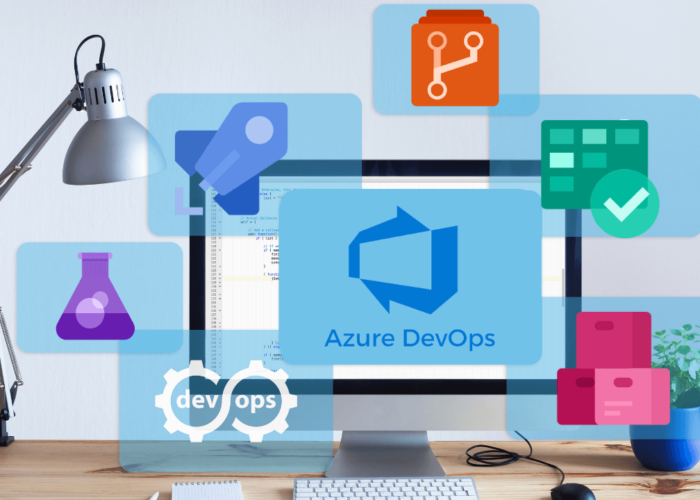Companies at the forefront of innovation are adopting API architectures to catalyse their expansion. Revolutionise your workflow seamlessly across hybrid and multi-cloud environments with the help of a centralised hub for end-to-end API management – Microsoft Azure API Management. In this article, we’ll explore the basics of it and answer common questions.
1. What is Azure API Management?
Azure API Management is a fully managed platform that enables organisations to create, publish, secure, and analyse APIs. It acts as a gateway, allowing businesses to control access, monitor usage, and protect their APIs from potential threats. With it, developers can streamline the API lifecycle, from design and deployment to monitoring and scaling.
Key features of it
Here are some key features and aspects of it:
API Creation and Design
It allows developers to create and design APIs using a user-friendly interface. This includes defining endpoints, specifying data formats, and setting up authentication methods.
Publishing APIs
Once APIs are created and configured, Azure provides a centralised platform for publishing them. This makes APIs accessible to internal development teams, external partners, or third-party developers.
Security and Access Control
Security is a crucial aspect of API management, and Azure offers robust features for securing APIs. This includes authentication mechanisms such as API keys, OAuth, and client certificates. Access control policies can be implemented to restrict or allow access based on specific criteria.
Monitoring and Analytics
It provides monitoring and analytics tools that allow organisations to track API usage, performance, and errors. This information is valuable for optimizing APIs, identifying potential issues, and ensuring a smooth user experience.
Rate Limiting and Quotas
To prevent abuse or overuse of APIs, it allows administrators to implement rate limiting and quotas. This ensures fair usage and helps maintain system stability.
Developer Collaboration
The platform facilitates collaboration between development teams by offering developer portals. These portals serve as a central hub where developers can discover, explore, and understand available APIs. Documentation, code samples, and testing capabilities are often included to streamline the development process.
Versioning and Lifecycle Management
APIs evolve over time, and Azure supports versioning to manage changes effectively. This ensures that existing applications relying on specific API versions remain functional while new versions are introduced.
Scalability and High Availability
As API usage grows, Azure scales horizontally to handle increased demand. It also provides features for high availability, ensuring that APIs are consistently accessible and reliable.
Integration with Azure Services
It integrates with other Azure services, allowing organisations to leverage a broader ecosystem of tools and services. This includes integration with Azure Logic Apps, Azure Functions, and Azure Active Directory for enhanced functionality.
2. Is Azure API Management the same as API Gateway?
While both Azure API Management and API gateways facilitate the management of APIs, they serve different purposes. An API gateway is typically a component within a larger API management solution. Azure API Management, on the other hand, is a comprehensive platform that encompasses API gateway functionalities along with additional features such as analytics, developer collaboration tools, and more. In essence, Azure APIM can be considered an API gateway, but it offers a broader spectrum of capabilities.
API Gateway
An API gateway is a server that acts as an intermediary between an application and a set of microservices or APIs. Its primary function is to handle tasks such as request routing, composition, and protocol translation.
API gateways play a crucial role in simplifying the client-side experience, ensuring security, and optimising communication between services. They are often part of a larger API management strategy or a component of an API management solution, but may lack certain features provided by a more comprehensive API management solution.
Azure API Management
As we have already mentioned, Azure API Management is a comprehensive API Management platform provided by Microsoft Azure. While it includes API gateway functionalities, it goes beyond the basic gateway capabilities.
In essence, while an API gateway focuses primarily on request routing and protocol translation, Azure API Management is a more extensive solution that covers the entire API lifecycle. It serves as a centralised hub for designing, publishing, securing, monitoring, and evolving APIs. While Azure includes API gateway capabilities, it also offers additional features that make it a robust choice for organisations looking for a comprehensive API management solution.
3. Is API Management Free on Azure?
Azure API Management is not entirely free, It follows a pay-as-you-go model. Its pricing structure is based on various factors such as the number of API calls, data transfer, and additional features used. Microsoft provides different pricing tiers to accommodate varying business needs, from small startups to large enterprises. While there may be a free tier with limited features, businesses should carefully assess their requirements and choose an appropriate pricing plan that aligns with their needs.
Here you can find the Azure pricing for more information: Azure Pricing & Licensing
For production or more extensive usage scenarios, Azure has 2 versions of the pricing tiers with different features, catering to different performance requirements. In this article we will mention them without going into detail.
Some key factors that contribute to the Azure API Management pricing include:
- Number of API calls: Pricing may be based on the total number of API calls made, often measured in calls per second (CPS) or calls per month.
- Data transfer: Costs may be associated with the amount of data transferred in and out of the API gateway.
- Additional features: Depending on the chosen pricing plan, businesses may incur costs for specific features such as increased CPS limits, advanced analytics, custom domains, developer collaboration tools, and more.
- Performance and Scaling: Higher-performance plans with greater scalability may have higher associated costs.
4. Is Azure API Management PaaS or SaaS?
Azure API Management is categorised as a Platform-as-a-Service (PaaS) offering. In a PaaS model, the underlying infrastructure and management of resources are handled by the service provider, in this case, Microsoft Azure. This allows organisations to focus on developing and managing their APIs without the burden of infrastructure maintenance. The PaaS model provides scalability, flexibility, and ease of management for businesses looking to streamline their API operations.
5. Common scenarios to use it
Azure API management can be useful in many scenarios, and we will mention some of them in this article.
Legacy System Modernisation
Utilise Azure to abstract and modernise legacy systems, making them accessible to modern applications and cloud services without the challenges of migration.
Application Integration
Simplify and reduce the cost of application integration by employing APIs as consumable, standards-based, and self-describing mechanisms for exposing and accessing data, applications, and processes.
Multi-Channel user experiences
Improve user experiences across various channels, including web, mobile, wearable, and IoT applications, by leveraging APIs. Reusing APIs accelerates development and boosts return on investment.
B2B Integration
Lower the barriers to business-to-business (B2B) integration by exposing APIs to partners and customers. This facilitates the exchange of data and the integration of business processes, eliminating the overhead associated with point-to-point integration.
Read this article if you want to have more information: “APIs in Open Insurance: the crucial role of the API Management Platform”
Conclusion
Azure API Management emerges as a powerful solution for businesses seeking efficient API management, from design to deployment and beyond. It goes beyond the capabilities of a typical API gateway, offering a comprehensive set of tools for securing, monitoring, and analysing APIs. While it is not entirely free, the flexible pricing plans cater to the diverse needs of organisations. As a Platform-as-a-Service offering, Azure API Management simplifies API management, allowing businesses to focus on innovation and growth.
For those considering the implementation of Azure API Management and seeking expert guidance, Chakray stands ready to assist. Our team of experienced professionals can provide tailored solutions to ensure a great experience. Contact Chakray today, and let one of our experts guide you through the process, and discover the full potential of it for your business.


Talk to our experts!
Contact our team and discover the cutting-edge technologies that will empower your business.
contact us





